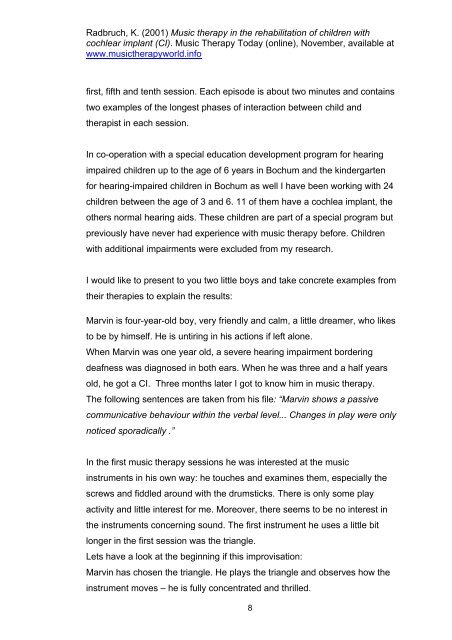Music therapy in the rehabilitation of children - World Federation of ...
Music therapy in the rehabilitation of children - World Federation of ...
Music therapy in the rehabilitation of children - World Federation of ...
You also want an ePaper? Increase the reach of your titles
YUMPU automatically turns print PDFs into web optimized ePapers that Google loves.
Radbruch, K. (2001) <strong>Music</strong> <strong><strong>the</strong>rapy</strong> <strong>in</strong> <strong>the</strong> <strong>rehabilitation</strong> <strong>of</strong> <strong>children</strong> with<br />
cochlear implant (CI). <strong>Music</strong> Therapy Today (onl<strong>in</strong>e), November, available at<br />
www.music<strong><strong>the</strong>rapy</strong>world.<strong>in</strong>fo<br />
first, fifth and tenth session. Each episode is about two m<strong>in</strong>utes and conta<strong>in</strong>s<br />
two examples <strong>of</strong> <strong>the</strong> longest phases <strong>of</strong> <strong>in</strong>teraction between child and<br />
<strong>the</strong>rapist <strong>in</strong> each session.<br />
In co-operation with a special education development program for hear<strong>in</strong>g<br />
impaired <strong>children</strong> up to <strong>the</strong> age <strong>of</strong> 6 years <strong>in</strong> Bochum and <strong>the</strong> k<strong>in</strong>dergarten<br />
for hear<strong>in</strong>g-impaired <strong>children</strong> <strong>in</strong> Bochum as well I have been work<strong>in</strong>g with 24<br />
<strong>children</strong> between <strong>the</strong> age <strong>of</strong> 3 and 6. 11 <strong>of</strong> <strong>the</strong>m have a cochlea implant, <strong>the</strong><br />
o<strong>the</strong>rs normal hear<strong>in</strong>g aids. These <strong>children</strong> are part <strong>of</strong> a special program but<br />
previously have never had experience with music <strong><strong>the</strong>rapy</strong> before. Children<br />
with additional impairments were excluded from my research.<br />
I would like to present to you two little boys and take concrete examples from<br />
<strong>the</strong>ir <strong>the</strong>rapies to expla<strong>in</strong> <strong>the</strong> results:<br />
Marv<strong>in</strong> is four-year-old boy, very friendly and calm, a little dreamer, who likes<br />
to be by himself. He is untir<strong>in</strong>g <strong>in</strong> his actions if left alone.<br />
When Marv<strong>in</strong> was one year old, a severe hear<strong>in</strong>g impairment border<strong>in</strong>g<br />
deafness was diagnosed <strong>in</strong> both ears. When he was three and a half years<br />
old, he got a CI. Three months later I got to know him <strong>in</strong> music <strong><strong>the</strong>rapy</strong>.<br />
The follow<strong>in</strong>g sentences are taken from his file: “Marv<strong>in</strong> shows a passive<br />
communicative behaviour with<strong>in</strong> <strong>the</strong> verbal level... Changes <strong>in</strong> play were only<br />
noticed sporadically .”<br />
In <strong>the</strong> first music <strong><strong>the</strong>rapy</strong> sessions he was <strong>in</strong>terested at <strong>the</strong> music<br />
<strong>in</strong>struments <strong>in</strong> his own way: he touches and exam<strong>in</strong>es <strong>the</strong>m, especially <strong>the</strong><br />
screws and fiddled around with <strong>the</strong> drumsticks. There is only some play<br />
activity and little <strong>in</strong>terest for me. Moreover, <strong>the</strong>re seems to be no <strong>in</strong>terest <strong>in</strong><br />
<strong>the</strong> <strong>in</strong>struments concern<strong>in</strong>g sound. The first <strong>in</strong>strument he uses a little bit<br />
longer <strong>in</strong> <strong>the</strong> first session was <strong>the</strong> triangle.<br />
Lets have a look at <strong>the</strong> beg<strong>in</strong>n<strong>in</strong>g if this improvisation:<br />
Marv<strong>in</strong> has chosen <strong>the</strong> triangle. He plays <strong>the</strong> triangle and observes how <strong>the</strong><br />
<strong>in</strong>strument moves – he is fully concentrated and thrilled.<br />
8

















